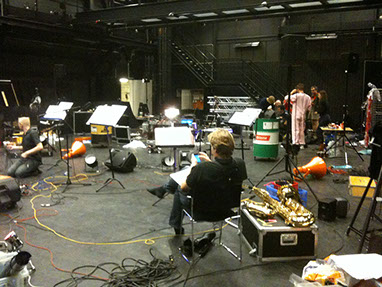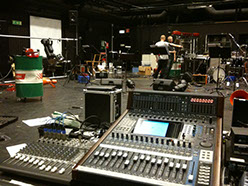Examples
Read more
Examples
5.1.4-5.1.6
When I started composing Indy500: seklernas udde I was unsure how I would actually approach composing for actors and how to write the score. I did not want to use a traditional, precise rhythmical notation on how the actors should perform the words. Partly because they are not trained in reading music, but primarily because I find that such an approach of notating speech easily becomes stiff and limiting. Having said that, I should add that Olga Neuwirth in Todesraten used precise notation for both actor and instrument, which works very well as both the CD-recording of the piece shows and the performances by Teatr Weimar and Ensemble Ars Nova showed. However, I know that in the latter case reading and interpreting the notation was difficult for the actor and caused him a tremendous amount of work.
I was initially planning to write the score and work out the electronic parts as I would normally do, but in order to find a way to tackle the compositional issue on how I should approach the text I decided to invite the actors to the studio. I felt it could be a good start for all of us to get to know the text by recording it and listening to it. After the session I began to edit their readings. I started to add electronics and sampled sounds to the actors’ voices to test how it would work. Gradually I started composing the piece, not by writing a score but by making a demo version of the piece, with software simulations of the acoustic instruments. With the help of a DAW I composed with the recorded text, cutting it, repeating sections and rearranging it, as I wanted. I could also alter the speed (without changing the pitch) of the recordings of the actors’ voices, which was an important feature for getting the right tempo of the readings. When we did the initial recordings we really had no idea of the tempo or the expressions for the text. What I unknowingly did through this process was a radio play – a radio play that we later performed live. However, at the time I just considered it a demo that I based my score on and that the performers could listen to preparing for the rehearsals.
EXAMPLE 5.1.4.a-f. Sound: Part E (Score around 8:30 - 11:00): First recordings, demo version and final performance version
Text in section E (Score part E around 8:30 - 11:00). Jörgen had already in his text suggested that some text parts should be overlapping, which is heard already in the first readings. In the final version I made much more extended use of superimpositions, rearranging parts of the text for musical resaons.
First reading of section E, extract, 24 June 2009 (Score part E around 8:30 - 9:00)
Discussions between director and actors of the section above, 24 June 2009
Second reading of section E, extract, starting from the entrance of actor 2, 24 June 2009 (Score part E around 8:30 - 9:00)
First demo version of the section E, extract October 2009 (Score part E around 8:30 - 9:00)
Final demo version of the section E, extract, beginning of F, November 2009 (Score part E 8:27 - 10:00)
Performance of the section E, extract, beginning of F, November 2009 (Score part E 8:27 - 10:00)
3 Att livet finns, existerar för att visa att döden finns. Hur skulle man annars veta att döden fanns. Om man inte levde. Jag tror att död och skönhet betyder samma sak. Det måste jag tro. Jag lever ju i döden, döden omger mig. Döden är ett metallskelett som omger mig. Livet tror att det där metallskelettet kommer att skydda mig när elden kommer men döden vet bättre. Döden vet alltid bäst. Döden vet alltid bäst för döden har genomskådat allting. Döden har genomskådat livet och därför lever vi. För att döden vet var skåpet ska stå och vet att om inte livet fanns skulle inte heller döden finnas.
1 Jag tror på döden. Jag tror på döden. Jag tror att döden väntar mig längre fram. / Vid nästa kurva.
3 Jag ska lura döden.
2 Jag tror att döden väntar mig längre fram. Vid nästa kurva. Eller nästa. Eller nästa. Eller nästa. Eller nästa. Eller nästa. Eller nästa. Eller nästa. Eller nästa. Eller nästa. Eller nästa. Eller nästa. Eller nästa. Eller nästa. Eller nästa. Eller nästa. Eller nästa. Eller nästa. Eller nästa. / Eller nästa. Eller nästa. Eller nästa. Eller nästa. Eller nästa. Eller nästa. Eller nästa. Eller nästa. Eller nästa. (övergår till bandstycke)
3 Eller jag ska lura. Döden.
1 Jag vet att en av kurvorna längre fram kommer att döda mig. Jag vet det. Jag vet det. jag vet det. Jag vet det. Det vet jag. Jag vet att döden finns där längre fram och väntar mig. Jag vet det. Jag vet det. Jag vet det. Jag vet det. Jag vet det. Jag vet det. Jag vet det. Jag vet det. Jag vet det. Jag vet det. Jag vet det. Jag vet det. Jag vet det. Jag vet det. Jag vet det. Jag vet det. Jag vet det. Jag vet det. Jag vet det. Jag vet det. Jag vet det. Jag vet det. Jag vet det. Jag vet det.
3 Eller jag ska. Lura döden. I varje kurva tvingar jag marken mot min kropp. Som en älskare och älskarinna och älskarinna och älskare möts våra kroppar. Fyra gånger per varv. Fyra gånger per varv. Fyra gånger per varv. Fyra gånger per varv. Fyra gånger per varv. Fyra gånger per varv. Fyra gånger per varv. Fyra gånger per varv. Fyra gånger per varv. Fyra gånger per varv. Fyra gånger per varv. Fyra gånger per varv.
Score extract of section E of Indy500: seklernas udde
(Score part A 8:20 - 10:20) :
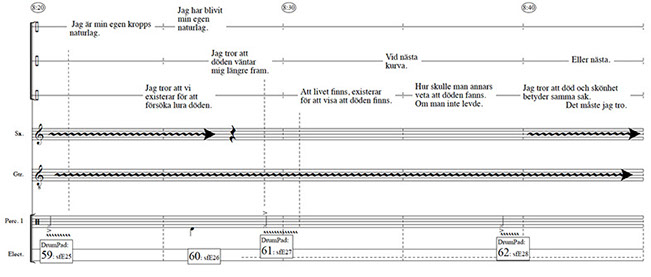
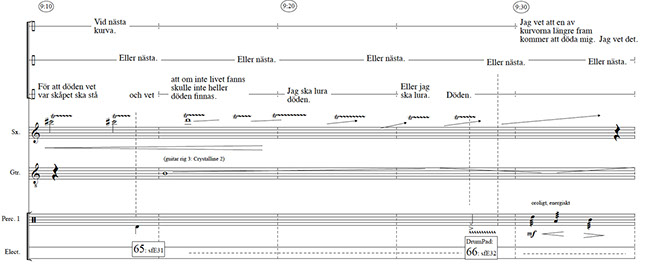
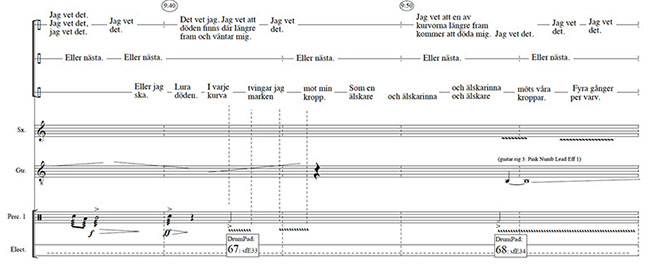

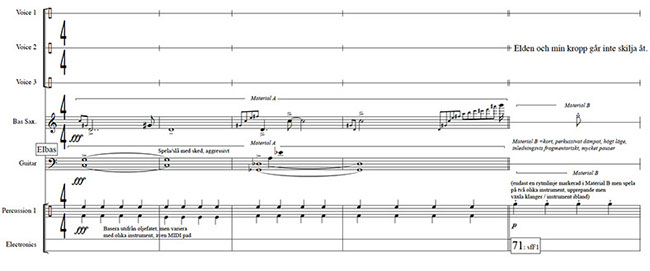
Score extract of section F, first page:
Since the temporal alignment of the parts in the computer was mostly carried out based on seconds, not in musical beats and bars, also the score is based on minutes and seconds. The actors’ lines were written as chunks of text that were consistent with the graphical representation of time in minutes and seconds. In this way the tempo of the text to be spoken was indicated approximately. Precise interaction within the ensemble and with the electronics was achieved by marking exactly which word or musical figure that would trigger actions for the other performers and the electronics. The final score became a mix of notational techniques: traditional musical notation for instruments in measured sections, proportional unmeasured notation indicating time with minutes and seconds for text and freer sections for the instruments, instructions for certain performance actions and for the electronics, and the indications for actions-reactions between performers.

Rehearsal session, Rafael Pettersson, Daniel Nyström, Jörgen Pettersson, Linda Ritzén
First reading of section A of Indy500: seklernas udde (Score part A 1:20 - 2:10)
EXAMPLE 5.1.5. a-b Sound: Part A (Score 1:20 - 2:05), first recording and demo version
1 Ray Harroun är profeten som beskrev värdet av hastighet.
3 Även Ray hastighet.
1 Och Kenny från Sverige hans lärjunge.
3 Även Kenny hastighet.
1 Gör gud av människan krävde människan.
3 Även Gud hastighet.
1 Gör gud av människan krävde människan…
3 Även Gud hastighet.
1 och Ray visade människan hur.
3 Även Ray hastighet.
1 Genom hastighet kan vi lämna det mänskliga i oss…
3 Även hastighet hastighet.
1 … och bli till gudar.
3 Hastighet gör gud av människan. Och vi är dess kyrka: / Honda. Ferrari. Toyota. Renault, BMW, Mercedes. Pirelli. Firestone. Bridgestone, Shell,
1 Och vi är dess kyrkas tillskyndare: Marlboro. Philip Morris. Mobil. Bosch. Camel. Argent. 7-eleven.
1 Ray Harroun is the prophet that described the vakue of speed.
3 Also Ray speed.
1 And Kenny from Sweden his disciple.
3 Also Kenny speed.
1 Make god of man demanded man.
3 Also God speed.
1 Make god of man demanded man...
3 Also God speed.
1 and Ray showed man how.
3 Also Ray speed.
1 Through speed we can leave the human within us…
3 Also speed speed.
1 … and become gods.
3 Speed makes god of man. And we are its church: / Honda. Ferrari. Toyota. Renault, BMW, Mercedes. Pirelli. Firestone. Bridgestone, Shell,
1 And we are the church's proponents: Marlboro. Philip Morris. Mobil. Bosch. Camel. Argent. 7-eleven.
Demo version of section A of Indy500: seklernas udde (Score part A 1:20 - 2:10)
EXAMPLE 5.1.6. Sound: Part A (Score 1:20 - 2:05), final performance version
Performance recording of section A of Indy500: seklernas udde (Score part A 1:20 - 2:10)
Score extract of section A of Indy500: seklernas udde (Score part A 1:20 - 2:05):
This highly pragmatic way of writing the score turned out to be very successful. With the demo recording of the piece and a score that was working well for both actors and musicians, as well as for the interplay within the ensemble, already the very first rehearsal ran efficiently and sounded great. The initial process of recording the text and, subsequently, the way the score was written, would turn out to develop into important methods for many of our following works.
